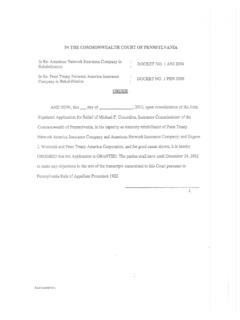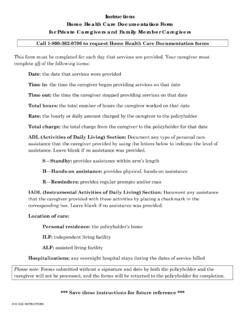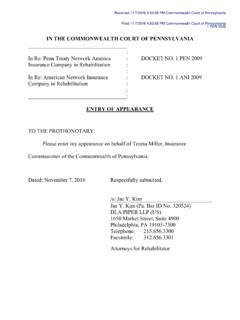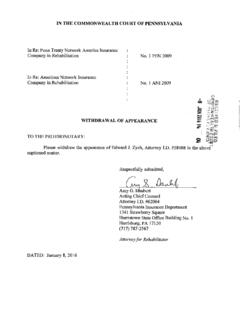Transcription of IN OF PENNSYLVANIA - Penn Treaty
1 IN THE COMMONWEALTH COURT OF PENNSYLVANIA In Re: Penn Treaty Network America Insurance Company in Rehabilitation 1 PEN 2009 In Re: American Network Insurance Company in Rehabilitation 1 ANI 2009 Re: Settlement Agreement BEFORE: HONORABLE MARY HANNAH LEAVITT, President Judge OPINION NOT REPORTED FILED: September 23, 2016 memorandum OPINION and ORDER Presently before the Court is a Verified Joint Application for Relief (Joint Application) filed by Teresa D. Miller, Insurance Commissioner of the Commonwealth of PENNSYLVANIA in her capacity as Statutory Rehabilitator of Penn Treaty Network America Insurance Company (PTNA) and American Network Insurance Company (ANIC) (collectively, Companies), Intervenors Eugene J. Woznicki and Penn Treaty American Corporation (PTAC)1 and Intervenor Broadbill Partners, LP (Broadbill),2 requesting the Court's approval of a Settlement Agreement.' The Joint Application has garnered objections from two other intervenors: (1) a group of parties to, or beneficiaries of, agency contracts with the Mr.
2 Woznicki and PTAC are collectively referred to as the "PTAC Intervenors." 2 The Rehabilitator, the PTAC Intervenors, and Broadbill are collectively referred to as the "Settling Parties." 3 The proposed Settlement Agreement is comprised of a memorandum of Understanding and other definitive agreements among the Settling Parties. Companies (Agents) and (2) a group of Health Insurers.' For the following reasons, the Court overrules the Agents' and Health Insurers' objections to the Joint Application. The Settlement Agreement is the culmination of many months of negotiations between the Settling Parties. It arranges for a coordinated tax strategy to mitigate tax liability for the Companies' estates, and therefore conserves and maximizes assets available to pay policyholder claims. In consideration for $10 million,' PTAC will (1) forbear from taking actions that would impair or eviscerate the Companies' ability to use a tax shield that belongs to the consolidated tax group; and (2) participate in seeking a Private Letter Ruling (PLR) from the United States Internal Revenue Service to resolve a potential tax liability being a Aetna Life Insurance Company, Anthem, Inc.
3 , Cigna Corporation, HM Life Insurance Company, Horizon Healthcare Services, Inc. d/b /a Horizon Blue Cross Blue Shield of New Jersey, QCC Insurance Company, United Concordia Life and Health Insurance Company, United Concordia Insurance Company and UnitedHealthcare Insurance Company. 5 The $10 million payment to PTAC will be classified as a first priority cost and expense of the administration of receivership, See Section 544(a) of The Insurance Department Act of 1921, Act of May 17, 1921, 789, Article V, added by the Act of December 14, 1977, 280, as amended, 40 (a). a The consolidated tax group refers to the parties to a Tax Sharing Agreement effective June 6, 2001, among PTAC and its subsidiaries, including PTNA and ANIC. The agreement, which was filed with the Insurance Department, forms the basis of tax payments made by the subsidiaries, if filing a consolidated return with PTAC. Pursuant to the agreement, the subsidiaries "shall make payments to [PTAC], as required, in an amount equal to the tax provision required as if the Subsidiaries were not a member of the controlled group.
4 " Joint memorandum of Law of Broadbill and PTAC, Exhibit 1. The agreement further provides that "[a]t [PTAC]'s discretion, the Subsidiaries may be entitled to calculate and receive credit for any tax benefit or expense resulting from any credits or expenses arising as a result of inclusion in the controlled group, including but not limited to .. the use of parent company net operating losses[.]" Id. The Rehabilitator and PTAC Intervenors disagree over the effect of the Tax Sharing Agreement and whether the Rehabilitator is authorized to use the net operating losses without PTAC's consent. Settlement of that disputed tax issue is a significant feature of the Settlement Agreement. 2 imposed upon die Companies' estates. More specifically, the Settlement Agreement allows PTNA and ANIC to gain access to up to $1 billion in net operating losses and tax exclusions available to the consolidated tax group through a PLR. The agreement permits the Companies to resolve significant tax issues for the Companies' estates and policyholders, including: (1) whether the Companies will incur discharge of indebtedness income as a result of cancelling part of their liabilities to policyholders; (2) control over the Companies' net operating loss carryforwards; (3) whether PTAC has the right to take a worthless stock deduction; and (4) whether policyholders, as a result of policy restructuring, will experience adverse tax consequences.
5 Litigation of those issues has already cost the Companies hundreds of thousands of dollars and, absent a settlement, will cost only more. Thus, the Settlement Agreement directly relates to "preserving .. the assets of the insurer," Section 544(a) of Article V, 40 (a), and will reduce the financial burden on state insurance guaranty associations.' Agents object to the Joint Application on several grounds. Agents assert that (1) the Joint Application fails to provide a sufficient evidentiary basis from which this Court may find that the proposed settlement is in the best interests of the insolvent insurers' policyholders, claimants, and the public; (2) the proposed classification of the $10 million cash payment to PTAC as an administrative expense entitled to first priority is contrary to Section 544(i) of Article V, 40 ' It is not unusual for a distressed insurance company to acquire the right to use valuable tax attributes through a settlement.
6 For example, in the Reliance Insurance Company liquidation, this Court approved a settlement agreement that allocated tax attributes similarly to the Settlement Agreement in the case sub judice. The Reliance case specifically provided for payments from the insurance estate to the parent for using consolidated net operating losses and designated such payments by the statutory liquidator as an administrative priority under Section 544(a) of Article V, 40 (a). 3 (i), which provides that payments for the claims of shareholders or other owners have the lowest priority and may be paid only after all other claims have been satisfied; and (3) the proposed settlement advances a bad public policy because it uses estate assets to "buy the silence" of the party uniquely positioned to challenge the Rehabilitator's assertion that liquidation is appropriate and attempts to use the power of this Court to set a bond for appeal to squelch any further judicial review of the proposed settlement.
7 Health Insurers object to the Joint Application for the following reasons: (1) the payment of $10 million to PTAC circumvents the statutory distribution scheme in Section 544 of Article V; (2) the payment to PTAC exceeds the benefits to policyholders, claimants and the public cited by the Settling Parties; (3) the Joint Application and proposed memorandum of Understanding among the Settling Parties is vague and does not provide the Court with sufficient information to weigh the competing contentions of the parties; and (4) there is no legal basis for conditioning an appeal on the posting of a $36 million bond. As a threshold matter, the Court must decide whether Agents and Health Insurers have standing to object to the Joint Application. This Court's previous order granted Health Insurers the status of limited intervenors .. for purposes of .. participation in the proceedings before the Commonwealth Court relating to the Second Amended [Rehabilitation] Plan (or any future modifications thereof), including discovery and appeal from order(s) on the proposed Plan and on petitions for liquidation or liquidation orders pursuant to such proposed Plan.
8 In Re: Penn Treaty Network America Insurance Company in Rehabilitation (Pa. Cmwlth., No. 1 PEN 2009, Stipulation and Order of Intervention, filed June 19, 2015) at 3. The Rehabilitator withdrew the Second Amended Rehabilitation Plan 4 by notice filed with the Court on July 27, 2016.$ Objecting to the Settlement Agreement is beyond the scope of the Court's limited intervention order. Health Insurers never sought, nor did the Court ever grant, a subsequent order expanding Health Insurers' limited right to intervene beyond the "discrete controversy" identified in the intervention order.' Moreover, Health Insurers do not explain how approving the Settlement Agreement will harm them directly, which the PENNSYLVANIA Supreme Court has held is a threshold question for establishing standing. Johnson v. American Standard, 8 318, 333 (Pa. 2010) ( "[A] party must be aggrieved in order to possess standing to pursue litigation. "). Unless adversely affected by the matter at issue, an entity is not aggrieved and thus "has no standing to obtain a judicial resolution of that challenge.
9 " Hospital & Health System Association of PENNSYLVANIA v. Department of Public Welfare, 888 601, 607 (Pa. 2005). This standard is even more stringent in the context of an insurance receivership proceeding. Under PENNSYLVANIA Rule of Appellate Procedure 3775, a limited intervenor such as Health Insurers must have "a direct and substantial interest" in a "discrete controversy relating to the administration of the insurer's business or estate[.]" Pa. 3775(a), (c)(2). 8 On July 27, 2016, the Rehabilitator filed Verified Petitions to Convert Rehabilitation to Liquidation. The conversion petitions are a separate and distinct part of this receivership proceeding, subject to specific provisions of Article V governing, inter alta, actions by and against the statutory liquidator and the proof of claim process. See generally Sections 526 -548 of Article V, 40 - 9 See Pa. 3775(c)(2) ( "Limited intervention. When the applicant's interest involves a discrete controversy relating to the administration of the insurer's business or estate, the Court may grant the applicant limited intervention to participate as a party in the discrete controversy.)
10 "). 5 Conspicuously absent from Health Insurers' objections is any explanation of how they will be aggrieved by the Settlement Agreement, save for a single conclusory statement that they "will bear the burden of the assessments from the state insurance guaranty associations." Health Insurers' Revised Objection to Application for Approval of Settlement Agreement at 13, This assertion of harm does not constitute a direct or immediate interest. Although the interests of Health Insurers and individual guaranty associations are not perfectly aligned, it bears noting that the guaranty associations, which have their own counsel, have not objected to the Joint Application. Even on their merits, Health Insurers' objections to the Settlement Agreement are unpersuasive. Health Insurers' objections focus primarily on the $10 million payment to They contend that the estates are not receiving fair value for the amount being paid and that the Rehabilitator did not pursue alternatives to the memorandum of Understanding that would have avoided such a payment.











